Key Points:
- Butler’s garter snakes have a preference for leeches and worms in their diet and they do not have as much dietary variety as other types of garter snakes.
- Kingsnakes have a unique ability to be immune to the venom of all venomous snakes that are found in Ohio, which makes it possible for them to consume venomous snakes as a part of their diet.
- Copper-bellied water snakes can display two different colors, black or brown, but usually their color is black.
As the seasons change in Ohio and the weather gets warmer, snakes come out of brumation and begin hunting prey before it’s time to mate. This is when most human confrontations with snakes occur, so it’s prudent to know a little bit about nine of the black snakes you may encounter in Ohio.
Snakes are just as vital to the health of an ecosystem as butterflies and bees because they keep the pest population in check. Despite that, many still fear any kind of encounter with a snake. What are nine of the black snakes in Ohio? We’ll look at them now.
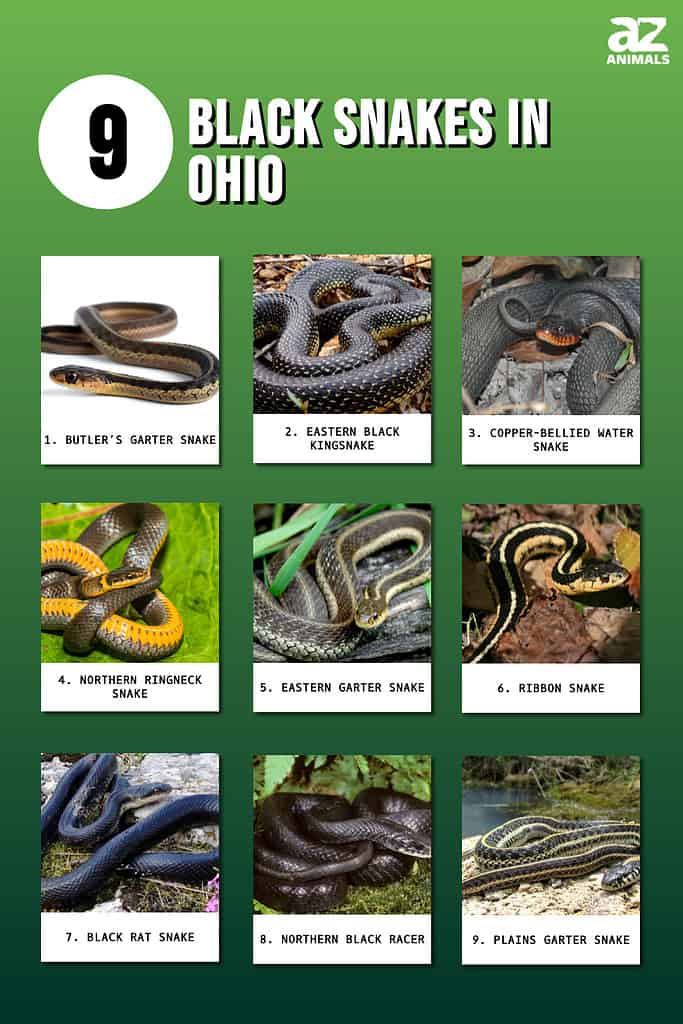
1. Butler’s Garter Snake
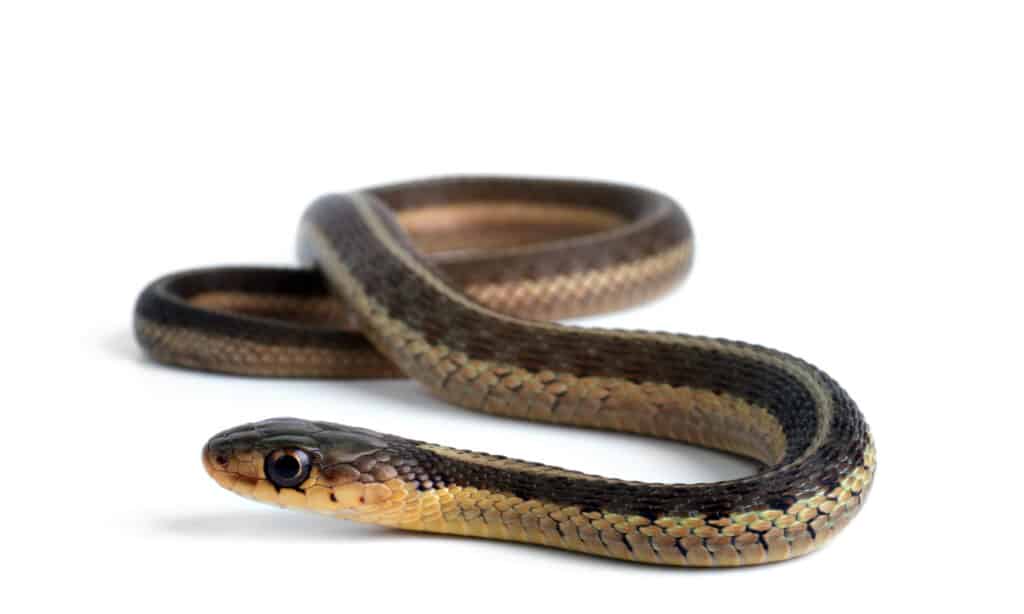
Butler’s garter snakes in northwestern Ohio exist in isolated populations.
©Michiel de Wit/Shutterstock.com
Leeches and worms are a favorite of Butler’s garter snakes, and their diet isn’t as varied as their other garter snake cousins. These garter snakes are endemic to North America and populate northwestern Ohio. They only exist in isolated groups and are not prolific. They like flat fields without much cover as well as grasslands, marshes, and meadows.
Butler’s garter snakes are smaller snakes and average a little under two feet long. They have three distinct stripes usually cast over a black or brown body.
2. Eastern Black Kingsnake

Eastern black kingsnakes eat other venomous snakes.
©Matt Jeppson/Shutterstock.com
Kingsnakes eat venomous snakes because they’re immune to the venom of all of the venomous snakes native to Ohio. They’re also constrictors. They’re mainly restricted to river bottomlands. These snakes are not a common sight because they’re secretive and nocturnal.
3. Copper-Bellied Water Snake
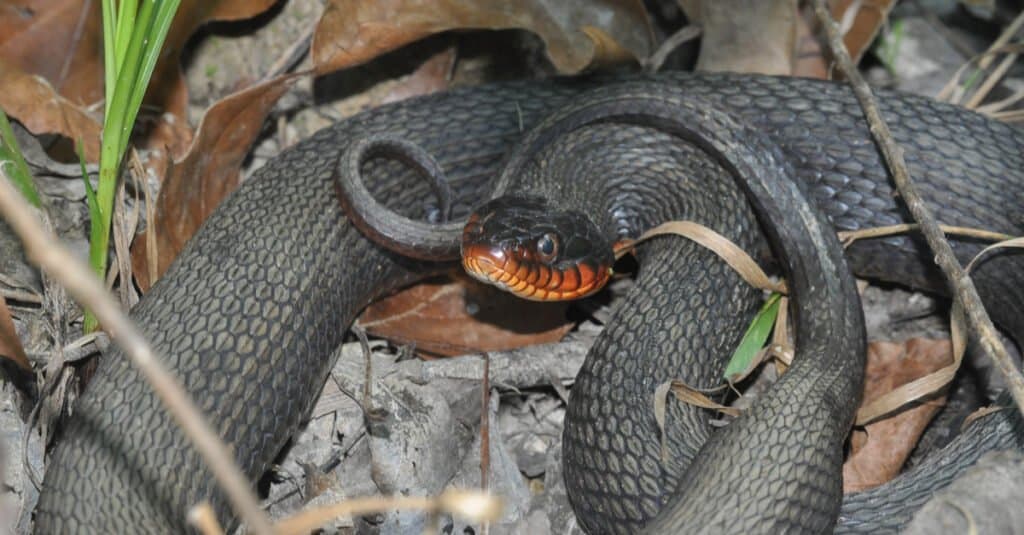
Copper-bellied water snakes are present in Williams County in Ohio.
©Mike Wilhelm/Shutterstock.com
Copper-bellied water snakes are usually black, but they can also be brown. Their undersides are usually somewhere between scarlet and orange. Copper-bellied water snakes grow to be about three to four feet long. They only live in Williams County and are not widespread across Ohio. That’s because most of their wetland habitats no longer exist.
4. Northern Ringneck Snake
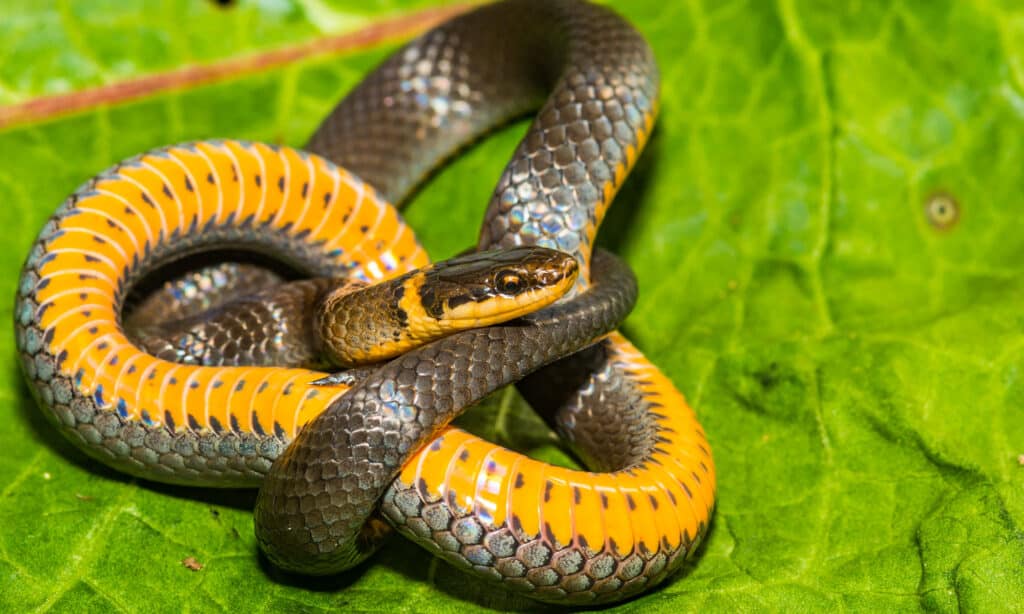
Northern ringneck snakes in Ohio are widespread in the southeast and along Lake Erie.
©Jay Ondreicka/Shutterstock.com
Northern ringneck snakes are nocturnal and are abundant in southeastern Ohio and along Lake Erie. That’s because there’s plenty of suitable habitat for them in that part of the state. They like rocky hillsides covered with trees. During the day, when they are inactive, they like to hide under boards, logs, stones, and in other tucked-away spots.
Northern ringneck snakes are mostly black except for a colored ring around their neck and matching bellies. This ring is usually yellow or orange, but it can vary. These snakes are one of the smallest in Ohio, maxing out at about a foot and a half long.
5. Eastern Garter Snake

Eastern garter snakes are the most common garter snakes in Ohio.
©Erik Agar/Shutterstock.com
The eastern garter snake is a common snake often referred to as the garden snake. This type of garter snake is the most common in Ohio, though it’s one of five types of garter snakes in the state. It makes dinner out of frogs, minnows, mice, slugs, earthworms, toads, and frogs. This snake is small and slender and averages about 2.5 feet in length.
Eastern garter snakes are usually black-bodied with yellow stripes. Like most snake species, this is highly variable. Near Lake Erie, there is an eastern black garter snake that’s almost all black with just a white chin.
These snakes are called garter snakes because they look like the sock garters that people used to keep their socks from slipping down their legs. They’re found around people, especially near creeks and streams. People often spot them in basements and near chicken coops, where they’ll readily eat eggs and small birds.
6. Ribbon Snake
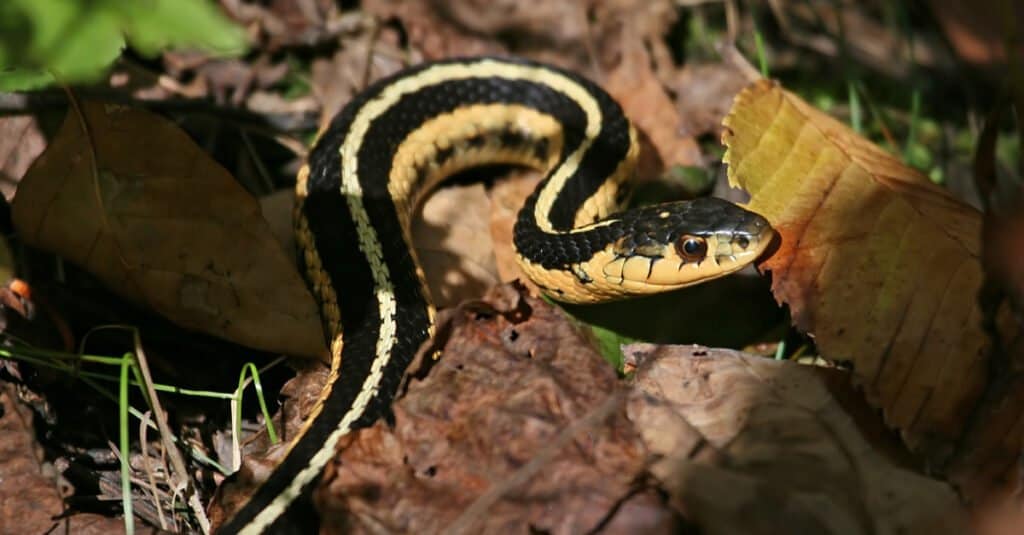
Ribbon snakes are most comfortable near water in Ohio.
©John Czenke/Shutterstock.com
You can spot ribbon snakes along almost any shoreline in Ohio. When confronted, they flee to their nearest water source. They look like garter snakes, except their stripes are always solid and never spotted.
Ribbon snakes are never far from water, and they’re swift when swimming. They like to eat aquatic animals like toads, frogs, salamanders, fish, and tadpoles.
7. Black Rat Snake
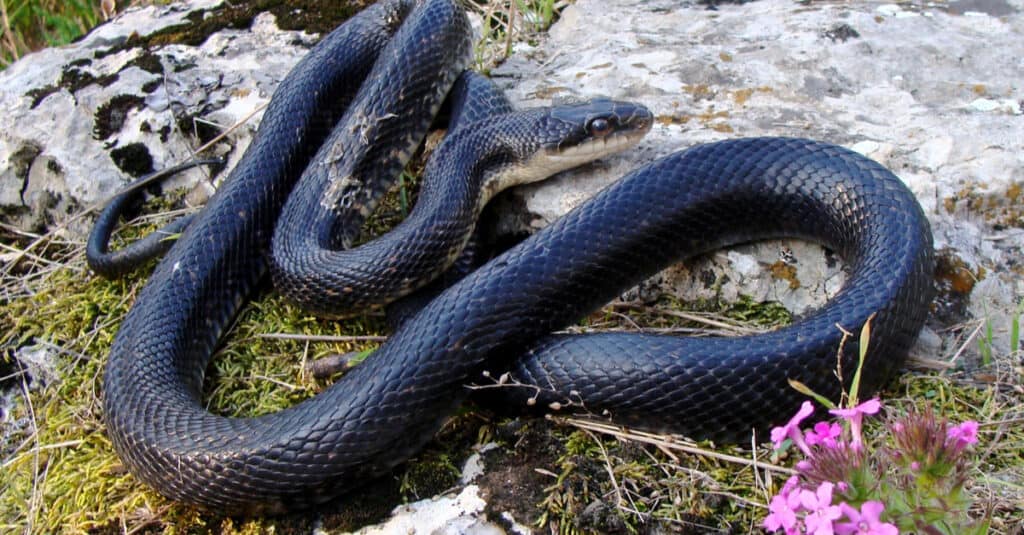
Black rat snakes eat venomous snakes.
©Matt Jeppson/Shutterstock.com
Black rat snakes are the longest snakes in Ohio at four to six feet long, though they can grow up to eight feet. Their bodies are black, with a light color peeping between the scales. They hang out in fields, agricultural areas, and forests.
They’re constrictors that will readily climb trees so they can dine on birds and their eggs. Because these snakes easily live in human-inhabited areas, they’re frequently killed out of fear.
Black rat snakes are also called gray rat snakes because their bodies are commonly gray instead of black. Other names include oak snakes, pilot snakes, and chicken snakes. As babies, they aren’t black and are gray with dark patterning. This makes them look like young copperheads and black rat snakes are often unnecessarily dispatched. Copperheads are highly venomous, while black rat snakes are not.
Black rat snakes eat venomous snakes, so they’re even more valuable for pest control purposes than other species of snake. They keep the dangerous snake population down through their predation.
8. Northern Black Racer
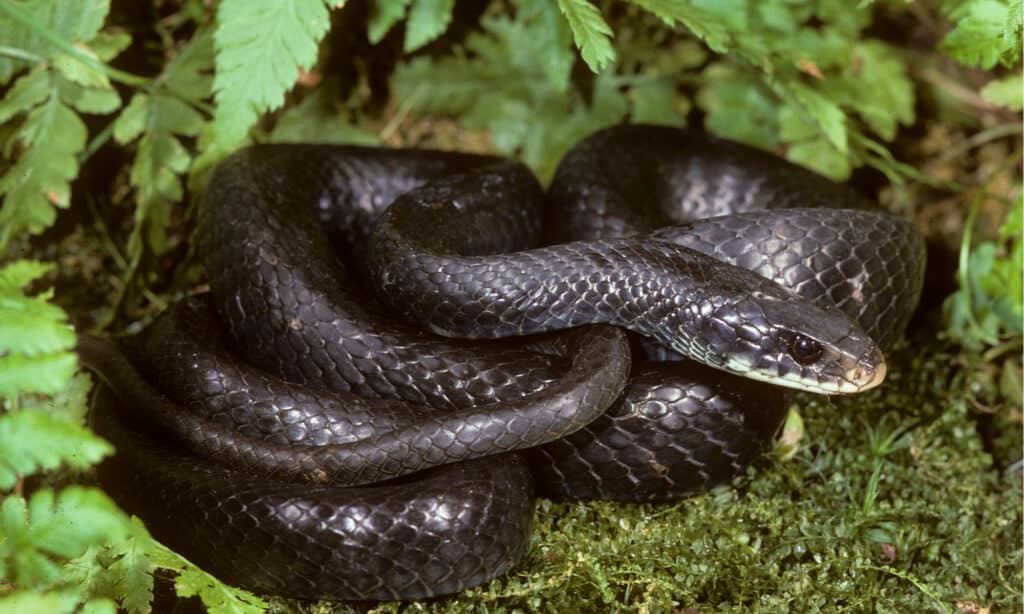
Northern black racers can be found in eastern Ohio.
©Breck P. Kent/Shutterstock.com
Northern black racers live in eastern Ohio. They rely on their eyesight, so they readily approach things, animals, and people. This is unusual for a snake, but once they realize what’s going on, they almost always try to flee.
Blue racers have an overlapping territory with northern black racers in Ohio, and in this region, they interbreed. Their offspring look like either parents or some color in between. As the name suggests, blue racers are blue.
Black racers are often confused with black rat snakes, but there are a few subtle differences between them, such as length and scale texture.
9. Plains Garter Snake
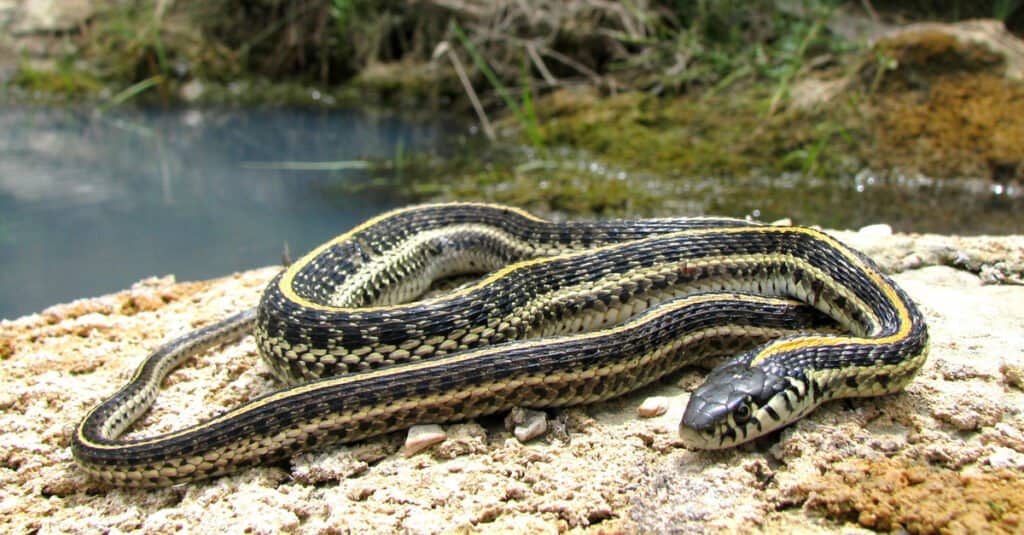
Plains garter snakes only exist in Wyandot County.
©Joe Farah/Shutterstock.com
In Wyandot County, there is a small and isolated population of plains garter snakes. There used to be a huge wet prairie in Ohio, and these snakes live in the last bits left of their old habitat.
This garter snake shares a lot of the same characteristics as other garter snakes, except that it’s more selective about which habitat it will live in. That is one of the reasons that it isn’t thriving despite human encroachment like some of the other garter snakes on our list.
Summary of 9 Black Snakes in Ohio
Here’s a recap of nine black snakes present in the state of Ohio that we took a look at:
| Number | Snake | Habitat |
|---|---|---|
| 1 | Butler’s Garter Snake | Isolated groups in northwestern Ohio |
| 2 | Eastern Black Kingsnake | Mainly restricted to river bottomlands |
| 3 | Copper-Bellied Water Snake | Williams County |
| 4 | Northern Ringneck Snake | Southeastern Ohio and along Lake Erie |
| 5 | Eastern Garter Snake | Found in areas inhabited by people, especially near creeks and streams |
| 6 | Ribbon Snake | Along almost any shoreline in Ohio |
| 7 | Black Rat Snake | Fields, agricultural areas, forests and human-inhabited areas |
| 8 | Northern Black Racer | Eastern Ohio |
| 9 | Plains Garter Snake | Wyandot County |
Other Reptiles Found in Ohio

Snapping turtles partially bury themselves in the mud and snap at prey moving by.
©Patrick Rolands/Shutterstock.com
Ohio is home to a diverse array of reptiles, from common species like garter snakes and turtles to more elusive ones like hognose snakes and smooth green snakes. These reptiles can be found in various habitats throughout the state, from grasslands and forests to wetlands and streams.
Some, like the copperhead and timber rattlesnake, are venomous and require caution when encountered. However, the majority of Ohio’s reptiles are harmless and play important roles in the ecosystem.
Here is a short list of other reptiles found in Ohio:
- Common five-lined skink
- Common snapping turtle
- Common musk turtle
- Eastern fence lizard
- Little brown skink
- Smooth softshell turtle.
How Can You Snake-Proof Your Property?
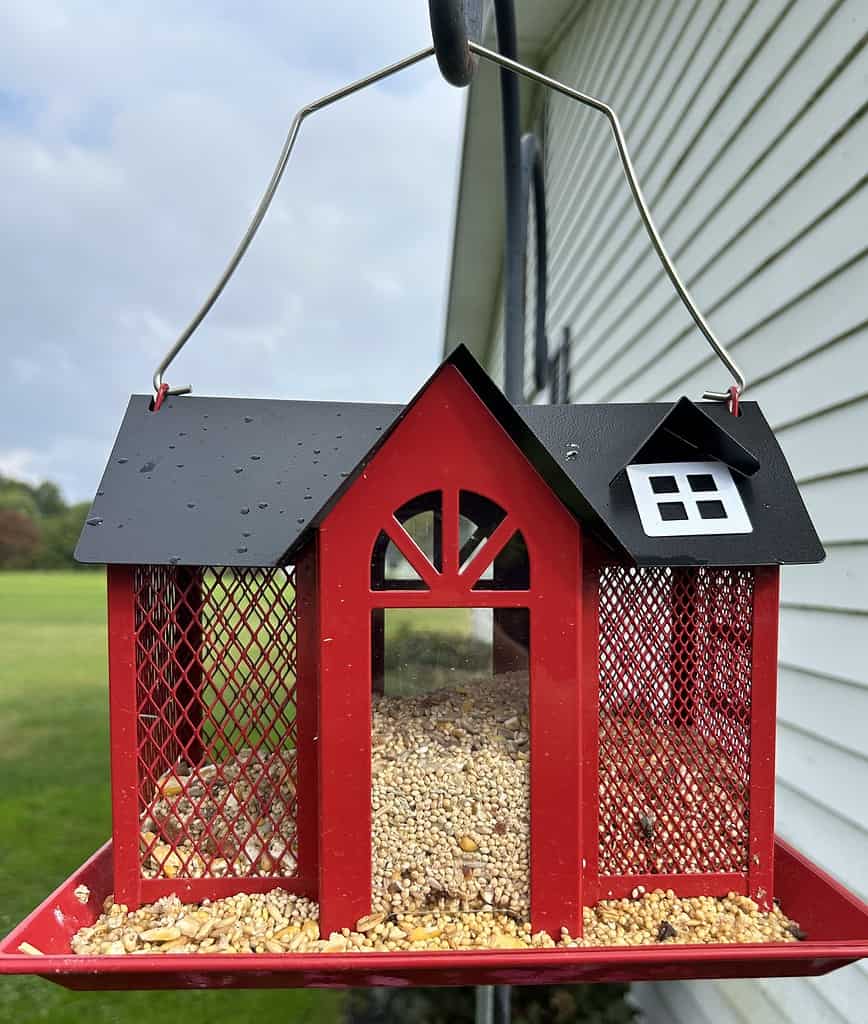
Birdfeeders are a fun way to attract wild birds, but don’t be surprised if snakes follow suit.
©Mcedm / CC BY-SA 4.0 – License
While the snakes in Ohio we examined are among those considered to be harmless to humans, that still doesn’t change the fact that some folks just don’t want snakes slithering around on their property! Here are some helpful tips to keep snakes away.
- Rid your yard of potential reptile shelters–any places where snakes can find shelter are attractive to them because they like to hide. Places they could hide would be leaf piles, wood piles, in empty containers like buckets or flower pots, or around large rocks. Checking for and removing these hiding places can discourage snakes.
- Lawn upkeep–Stay on top of mowing your lawn, as snakes can be attracted to tall, overgrown grass and brush.
- Rid your yard of any standing water–Standing water is a definite draw to snakes, whether it be ponds, bird baths, fountains, or puddles.
- Eliminate food sources for snakes–Snakes like to prey on rodents and birds, as well as other small mammals. If you have birdfeeders to attract wild birds, you could also be inviting snakes into the yard. Make sure to actively curtail rodents on your premises as well, as they also attract snakes.
- Have outdoor pets that scare away snakes–Dogs and cats are often enemies of snakes, as well as some kinds of chickens, so these are potential options for keeping snakes away.
The photo featured at the top of this post is © Breck P. Kent/Shutterstock.com
Discover the "Monster" Snake 5X Bigger than an Anaconda
Every day A-Z Animals sends out some of the most incredible facts in the world from our free newsletter. Want to discover the 10 most beautiful snakes in the world, a "snake island" where you're never more than 3 feet from danger, or a "monster" snake 5X larger than an anaconda? Then sign up right now and you'll start receiving our daily newsletter absolutely free.
Thank you for reading! Have some feedback for us? Contact the AZ Animals editorial team.






